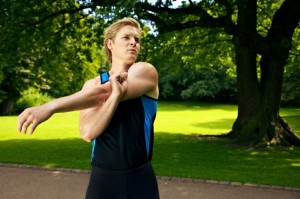You know you’ve had a successful day at the gym when you can “feel the burn” after an exercise session.  However, sometimes one may wake up the next day feeling sore to the point of discomfort. While muscle soreness after a workout is to be expected no matter what your fitness level, many people aren’t sure what to do about their muscle soreness. Should you allow your body to rest, or work through the muscles soreness after a workout? Why do we sometimes feel more muscle soreness two days after a workout?
However, sometimes one may wake up the next day feeling sore to the point of discomfort. While muscle soreness after a workout is to be expected no matter what your fitness level, many people aren’t sure what to do about their muscle soreness. Should you allow your body to rest, or work through the muscles soreness after a workout? Why do we sometimes feel more muscle soreness two days after a workout?
The following article from Spark People answers these questions regarding muscle soreness after a workout and outlines what should be done to maintain bodily health.
It’s common for beginners to experience muscle soreness that lasts for a week or two, just as seasoned exercisers will be sore after a tough work out. Yes, you should keep working out even though you are sore, but there is more to it than that.
Muscle soreness has two primary causes. The first soreness you experience happens during your workout (“the burn”) and should subside within a couple of hours. This is caused by lactic acid production. When you are training and your muscles are not getting enough oxygen (anaerobic glycolysis), lactic acid builds up. You can break down lactic acid by continuing to move and by doing light aerobic exercise (such as walking) after your workout. This is why cool-downs are so important, especially for beginners. The longer you cool down, the faster that lactic acid will leave the muscles (typically within an hour).
The type of muscle soreness you are experiencing, up to a day or two (and sometimes even three) after your workout is known as DOMS (Delayed Onset Muscle Soreness). DOMS is caused by microscopic tears inside the muscles, resulting from weight-training or fully exhausting the muscles during cardio. This is normal. Again, beginners will be more sore and usually for longer, but if you really worked as hard as you should have during a weight-lifting session, you should be somewhat sore for the next day or two.
This is where rest comes in. You absolutely must rest the muscles you worked for 1-2 days after a workout. Take at least one day off between strength training sessions, and if you are still very sore, take 2 days off. (This means from lifting, not from all exercise such as cardio). If you don’t let your muscles recover and repair, they will continue to break down and you will actually get weaker.
To help prevent soreness in the future, and alleviate some of it now, be sure to:
1. Always warm-up for 5-10 minutes and cool-down for at least 5 minutes.
2. Stretch after a warm-up, during your workout, and after you are done. Only stretch when your muscles are already warm from some kind of light activity.
3. Stay active. The more your muscles move, the faster they will recover from exercise and soreness. If you choose to rest completely instead of “actively recovering” with light exercise, you’ll probably be sore longer.
Written by Nicole Nichols, B.S. & Certified Fitness Instructor
There you have it. If you are experiencing muscle soreness after a workout, it is best to allow some time for the muscles to recover before extending them again. That doesn’t mean that you are allowed to spend a day lounging around on the couch, however. Staying active (even it just means talking a leisurely walk on sore legs) is the best route to quick recovery. Create an exercise schedule that works out a different part of your body each day, and then allow yourself 1-2 days of complete rest each week.
Avoiding injury is the most important part of working out. Ensure that you warm up and cool down before and after each training session. A simple massage of sore muscles may help relieve any minor pain.
If you have overworked your body and are experiencing prolonged muscle soreness after a workout, it might be time to contact your doctor or chiropractor. Call us at DeFalco Family Chiropractic and we would be happy to help you relieve any pain that you may have, whether chronic or temporary.
Do you gauge the success of your workout by the muscle soreness that you experience the next day?

